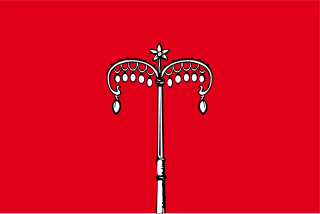Related Research Articles

Russia is divided into several types and levels of subdivisions.

The ranks and insignia used by Russian Ground Forces are inherited from the military ranks of the Soviet Union, although the insignia and uniform has been altered slightly.

Balashov is a town in Saratov Oblast, Russia, located on the Khopyor River. Population: 82,227 (2010 Census); 98,330 (2002 Census); 97,047 (1989 Census). It was previously known as Balashovo.

Atkarsk is a town in Saratov Oblast, Russia, located at the confluence of the Atkara and Medveditsa Rivers, 92 kilometers (57 mi) northwest of Saratov, the administrative center of the oblast. Population: 25,624 (2010 Census); 27,907 (2002 Census); 28,877 (1989 Census).

Biryuch is a town and the administrative center of Krasnogvardeysky District in Belgorod Oblast, Russia, located on the bank of the Tikhaya Sosna River. Its population was 7,114 (2021 Census); 7,846 (2010 Census); 8,079 (2002 Census); 8,526 (1989 Census)..

Amursky District is an administrative and municipal district (raion), one of the seventeen in Khabarovsk Krai, Russia. It is located in the southwest of the krai. The area of the district is 16,269 square kilometers (6,281 sq mi). Its administrative center is the town of Amursk. Population: 22,669 (2010 Census); 27,273 (2002 Census); 32,288 (1989 Census).

Bikinsky District is an administrative and municipal district (raion), one of the seventeen in Khabarovsk Krai, Russia. It is located in the southwest of the krai. The area of the district is 2,483 square kilometers (959 sq mi). Its administrative center is the town of Bikin. Population: 7,264 (2010 Census); 8,630 (2002 Census); 10,338 (1989 Census).

Khabarovsky District is an administrative and municipal district (raion), one of the seventeen in Khabarovsk Krai, Russia. It consists of two unconnected segments separated by the territory of Amursky District, which are located in the southwest of the krai. The area of the district is 30,014 square kilometers (11,588 sq mi). Its administrative center is the city of Khabarovsk. Population: 85,404 (2010 Census); 90,179 (2002 Census); 85,218 (1989 Census).

Komsomolsky District is an administrative and municipal district (raion), one of the seventeen in Khabarovsk Krai, Russia. It is located in the southern central part of the krai. The area of the district is 25,167 square kilometers (9,717 sq mi). Its administrative center is the city of Komsomolsk-on-Amur. Population: 29,072 (2010 Census); 31,563 (2002 Census); 33,649 (1989 Census).

Nikolayevsky District is an administrative and municipal district (raion), one of the seventeen in Khabarovsk Krai, Russia. It is located in the east of the krai. The area of the district is 17,188 square kilometers (6,636 sq mi). Its administrative center is the town of Nikolayevsk-on-Amur. Population: 9,942 (2010 Census); 13,850 (2002 Census); 19,683 (1989 Census).

Sovetsko-Gavansky District is an administrative and municipal district (raion), one of the seventeen in Khabarovsk Krai, Russia. It is located in the southeast of the krai. The area of the district is 15,534 square kilometers (5,998 sq mi). Its administrative center is the town of Sovetskaya Gavan. Population: 15,794 (2010 Census); 16,602 (2002 Census); 24,302 (1989 Census).

Rybnovsky District is an administrative and municipal district (raion), one of the twenty-five in Ryazan Oblast, Russia. It is located in the northwest of the oblast. The area of the district is 1,407 square kilometers (543 sq mi). Its administrative center is the town of Rybnoye. Population: 35,585 ; 37,140 (2002 Census); 38,744 (1989 Census). The population of Rybnoye accounts for 51.7% of the district's total population.

Saratovsky District is an administrative and municipal district (raion), one of the thirty-eight in Saratov Oblast, Russia. It is located in the center of the oblast. The area of the district is 1,900 square kilometers (730 sq mi). Its administrative center is the city of Saratov. Population: 48,105 ; 46,233 (2002 Census); 45,252 (1989 Census).
The municipal divisions in Russia, also called municipal formations, are territorial divisions of the Russian Federation which are formally granted the authority to manage local affairs through local self-government. As of January 1, 2020, there are 20,846 municipal divisions in Russia, including 1,673 municipal districts, 635 urban okrugs, and 33 municipal okrugs.

The Registered Cossacks of the Russian Federation, also referred to as neo-Cossacks, are a Cossack paramilitary formation that also performs non-military state services, on the basis of the Federal Law of the Russian Federation dated December 5, 2005 No. 154-FZ "On State Service of the Russian Cossacks".

The Federal Road Transport Agency, also known as Rosavtodor, is the Russian government agency responsible for overseeing the road transport industry and transport engineering in Russia.
The diplomatic ranks in the Russian Federation were introduced with enactment of the Federal Law of 27 July 2010 No.205-FZ. Diplomatic ranks are not to be confused with diplomatic positions.
1st class Active State Councillor of the Russian Federation is the highest federal state civilian service rank of Russia.
The special ranks in the Investigative Committee of Russia are defined by the article 20 of the Federal Law of 28 December 2010 No.403-FZ.
References
- ↑ "О государственной гражданской службе Российской Федерации" [Concerning the state civilian service of the Russian Federation]. Federal Law No. 79-FZ of 27 July 2004 (in Russian). State Duma.
- ↑ "О муниципальной службе в Российской Федерации" [Concerning the municipal service of the Russian Federation]. Federal Law No. 25-FZ of 2 March 2007 (in Russian). State Duma.